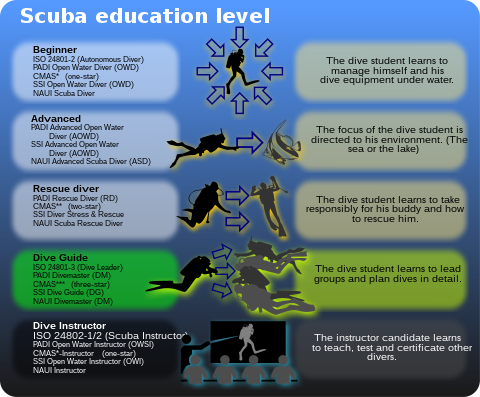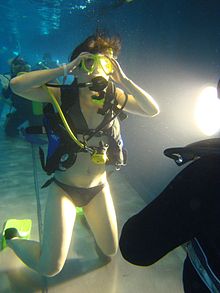

Recreational diver training is the process of developing knowledge and understanding of the basic principles, and the skills and procedures for the use of scuba equipment so that the diver is able to dive for recreational purposes with acceptable risk using the type of equipment and in similar conditions to those experienced during training.
Not only is the underwater environment hazardous but the diving equipment itself can be dangerous. There are problems that divers must learn to avoid and manage when they do occur. Divers need repeated practice and a gradual increase in challenge to develop and internalise the skills needed to control the equipment, to respond effective if they encounter difficulties, and to build confidence in their equipment and themselves. Diver practical training starts with simple but essential procedures, and builds on them until complex procedures can be managed effectively. This may be broken up into several short training programmes, with certification issued for each stage,[1] or combined into a few more substantial programmes with certification issued when all the skills have been mastered.[2][3]
Many diver training organizations exist, throughout the world, offering diver training leading to certification: the issuing of a "diving certification card," also known as a "C-card," or qualification card. This diving certification model originated at Scripps Institution of Oceanography in 1952 after two divers died while using university-owned equipment and the SIO instituted a system where a card was issued after training as evidence of competence.[4][5] Diving instructors affiliated to a diving certification agency may work independently or through a university, a dive club, a dive school or a dive shop. They will offer courses that should meet, or exceed, the standards of the certification organization that will certify the divers attending the course. The International Organization for Standardization has approved six recreational diving standards that may be implemented worldwide, and some of the standards developed by the (United States) RSTC are consistent with the applicable ISO Standards:[6]
The initial open water training for a person who is medically fit to dive and a reasonably competent swimmer is relatively short. Many dive shops in popular holiday locations offer courses intended to teach a novice to dive in a few days, which can be combined with diving on the vacation.[1] Other instructors and dive schools will provide more thorough training, which generally takes longer.[3] Dive operators, dive shops, and cylinder filling stations may refuse to allow uncertified people to dive with them, hire diving equipment or have their diving cylinders filled. This may be an agency standard, company policy, or specified by legislation.[7]
- ^ a b Cite error: The named reference
PADI manualwas invoked but never defined (see the help page). - ^ Cite error: The named reference
CMAStrgprogwas invoked but never defined (see the help page). - ^ a b Cite error: The named reference
GUE 2011was invoked but never defined (see the help page). - ^ Cite error: The named reference
Scrippswas invoked but never defined (see the help page). - ^ Cite error: The named reference
SIO Certificationwas invoked but never defined (see the help page). - ^ Cite error: The named reference
WRSTC ISOwas invoked but never defined (see the help page). - ^ Cite error: The named reference
Rec Diving Act 1979was invoked but never defined (see the help page).